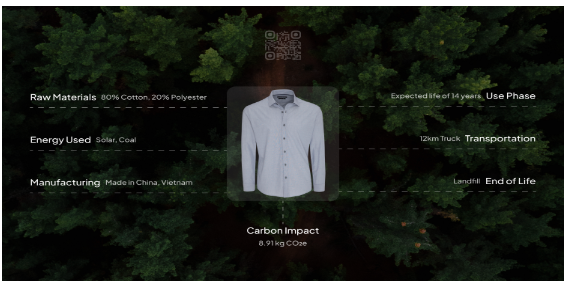 Introduction:
Introduction:
- The launch of the Digital Product Passport (DPP) offers a chance to create a system that is all-inclusive and able to store and distribute data covering all phases of a product’s life cycle.
- With the use of this system, companies, consumers, government agencies, and industry stakeholders would all be able to precisely determine the environmental impact of each and every element used in a product.
Understanding the Framework Behind the Digital Product Passport:
- A new Circular Economy Action Plan (CEAP) was approved by the European Commission (EC) in 2020, demonstrating the necessity for circular economy efforts to cover the full life cycle of a product, from the initial use of raw materials to the final disposal at the end of its useful life.
- The Circular Economy Package was first introduced in March 2022 and includes a proposal for the Ecodesign for Sustainable items Regulation (ESPR).
- This regulation is an extension of the Ecodesign Directive, which regulates energy-related items.
- This legislation promotes environmentally responsible product design concepts in an effort to strengthen the current framework.
- In addition to a 70% increase in yearly worldwide trash creation by 2050, the EU’s Circular Economy Action Plan (CEAP) projects that global consumption of commodities such as biomass, fossil fuels, metals, and minerals will double during the next 40 years.
- The existing “take-make-use-dispose” linear paradigm does not provide manufacturers with the incentives they need to emphasise circularity, leading to items that are frequently made for single-use and are difficult to repair or recycle.
- By facilitating the interchange of sustainability data, such as carbon footprints and recyclability across value chains, Digital Product Passports (DPPs) are anticipated to play a critical role in enabling novel approaches.
- DPPs can help with carbon reduction plans, business model innovations, new market development, social compliance reporting, and circular economy strategies. The development of a DPP strategy that is relevant to all situations is still lacking, nevertheless.
- The Commission wants to provide a general framework for DPPs that can be used for the majority of materials and products, in accordance with the EU’s planned Ecodesign for Sustainable Products Regulation (ESPR).
Sample Picture:
What are Digital Product Passports (DPP)?
- A “product passport” is defined by the European Commission as a product-specific dataset that can be electronically accessible through a data carrier to enable supply chain entities, authorities, and consumers to electronically register, process, and share product-related information.
- The DPP is a way to give detailed information on a product’s origin, composition, repairability, and choices for disassembly.
- It also contains details on a product’s use phase and the suitability of different components for recycling or proper end-of-life disposal.
- The advancement of circular economy techniques like predictive maintenance, repair, remanufacturing, refurbishing, and recycling depends heavily on this data.
- Furthermore, it raises stakeholder awareness and empowers consumers by offering insightful information on the sustainable qualities of materials and products.
Core Benefits to All Stakeholders in the Value Chain:
Improved Access to Product Sustainability Information:
- The DPP makes it possible for companies and decision-makers to obtain comparable and trustworthy data about the sustainability features of various products.
- This data facilitates decision-making processes pertaining to sustainability and helps handle issues with product liability.
Empowering Consumers with Informed Choices:
- The DPP gives consumers access to important information that enables them to make more knowledgeable and environmentally responsible purchases.
- The DPP gives consumers the ability to match their choices with their beliefs and preferences by facilitating transparency and clarity.
Improved Transparency, Traceability, and Consistency:
- Transparency and traceability are encouraged across the value chain by the DPP. Every link in the value chain has access to dependable and consistent information, which promotes trust and makes transactions and teamwork more effective.
Catalyst for Innovation and Circular Thinking:
- The DPP can stimulate creative thought, especially when it comes to circularity. It inspires new habits and pushes companies to investigate circular economy concepts and initiatives by offering thorough information on product lifetime and materials.
Potential for New, Sustainability Focused Business Models:
- The DPP has the potential to drive the development of entirely new business models.
- By offering detailed insights into product sustainability attributes, it opens up opportunities for businesses to differentiate themselves and create value through innovative and environmentally conscientious approaches and services.
Sources of Information for Sustainable Investment Choices:
- To facilitate sustainable investment decisions, the DPP creates new data and information channels.
- Investing decisions that are in line with sustainability goals can be made by investors by utilising the data that the DPP provides to assess a company’s environmental performance.
Enablement of Resource Optimization and Energy Efficiency:
- The DPP helps businesses to achieve efficiency and optimization goals by providing detailed information on the lifecycle and composition of products.
- Over the course of a product’s lifecycle, businesses might find ways to maximise resource utilisation and reduce environmental effects.
Who Needs to Implement a Digital Product Passport?
- Currently, the European Union is discussing the possibility of including a number of industries,such as consumer electronics, textiles, and batteries in the product passport program by 2026.
- This program falls inside the European Green Deal’s larger framework, with the exception of food, feed, and pharmaceutical items.
- As such, businesses who sell products in the EU will need to provide a product passport that includes both the finished product and its component parts. Although this regulation is exclusive to the EU, its effects will be felt worldwide.
How do you Make a Digital Product Passport for Your Products?
A Digital Product Passport (DPP) can be designed and implemented based on the following concepts, which are recommended from a business standpoint:
Ensuring Coherence and Consistency:
- The planned framework for the European Sustainable Products Regulation (ESPR) and the lessons discovered from the EU Battery Passport should be closely linked to and related from all upcoming EU legislation and activities that matter to DPPs.
- For the DPP to be implemented, the software and digital infrastructure should make every effort to be as compatible and interoperable as feasible with other systems.
- The EU, which should provide precise usage rules, should oversee the overall governance of DPP implementation. By establishing uniform standards, managing access rights, and developing an interoperable framework, the EU should also foster a supportive environment.
- To prevent duplication of effort and redundancy, it is recommended to utilise the extant global initiatives, techniques, and stakeholders pertaining to the harmonisation and standardisation of product data.
- DPPs ought to function as standards for environmentally friendly public procurement and as a means of supporting ecolabels.
- DPPs should enable a standardised method of information sharing that permits the sharing of data about things like carbon footprints and recycled content.
Embracing Adaptability:
- DPP testing and pilots should start as soon as possible, but on a limited and moderate size. They should also follow a staged strategy that permits ongoing extension and evolution in order to support iterative learning.
- To assess commonalities between various product groupings, pilot programs should include a wide range of well specified items and sectors.
- Rather than taking a one-size-fits-all approach, DPPs should include detailed data that is relevant to each product group in order to assure reliability and comparability.
Transparency and Traceability:
- DPPs ought to furnish investors, companies, and consumers with ample data so that they can prioritise sustainability criteria in their purchasing decisions and make better educated choices.
- Each piece of information should have a defined scope and specific user benefits throughout the product life cycle, and DPPs should only require pertinent and useful information.
- In order to maintain default openness throughout the value chain and accommodate valid confidentiality concerns, mandatory product information within DPPs should balance various levels of data access and data protection requirements.
- Reliable middlemen with a strong technical background and comprehension of the wider policy goals of DPPs in favour of a circular economy should be tasked with overseeing the operational implementation of DPPs.
Implementation Challenges:
Despite its benefits, the implementation of DPPs faces several challenges:
- Technical Integration: Establishing a standardised digital platform that can be widely adopted across industries.
- Data Privacy and Security: Ensuring sensitive information is protected while maintaining transparency.
- Global Standardisation: Developing and enforcing international standards for DPPs can be complex.
- Cost: The initial setup and ongoing maintenance of DPPs may be costly, especially for small and medium-sized enterprises (SMEs).
Future Prospects:
- Standardisation and Implementation: The European Union (EU) is a frontrunner in DPP adoption. A project called CIRPASS recently held a public event to discuss the current state and future possibilities of DPPs, particularly regarding implementation across various industries This suggests the EU is actively working on standardising and deploying DPPs.
- Expected Timeline: While the EU pushes for mandatory adoption by 2027, there’s still movement elsewhere. Events like the CIRPASS one indicate ongoing discussions and planning for wider DPP use beyond the EU.








 Authorised IMDS & CDX Training & Consulting partner for
Authorised IMDS & CDX Training & Consulting partner for





